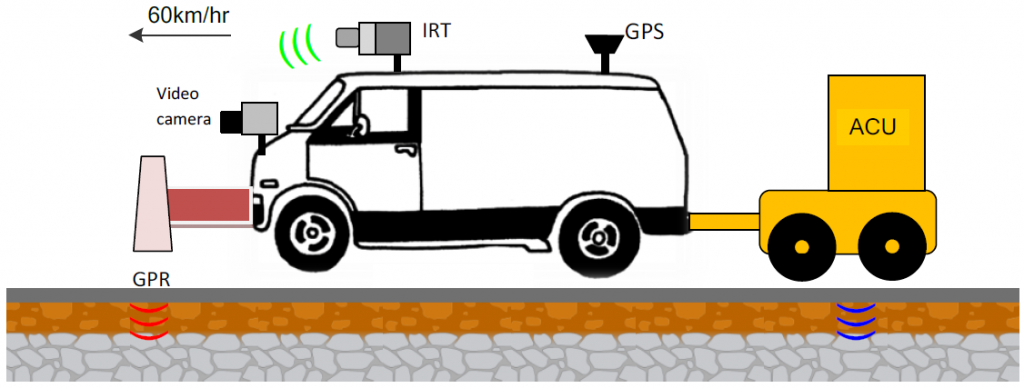The main objective of the project is development of a novel integrated NDT system for damage assessment, diagnosis and monitoring of pavements.
Scientific Objectives :
-
To provide advanced GPR, ACU and IRT systems for prompt assessment and monitoring of pavement structures at traffic speeds (up to 60 km/h) and with the ability to detect adjacent layers of similar materials, damage assessment in quantitative terms and pavement recoverable deflection.
- To develop an advanced ACU system for the identification of the thickness of pavements, operating with a broadband frequency spanning between 50 kHz and 100 kHz and an integrated multi-channel high pass filter to filter out low frequency components and eliminate mechanical noise.
- To develop an advanced GPR system especially designed for concrete materials, operating with a radar bandwidth (10db) between 100 and 1 GHz with a desired range resolution of 3cm in concrete and a maximum depth of inspection of 1m.
- To develop an advanced IRT imaging system with precision temperature measurement of up to 20,000 points on a single image and 60 Hz image refresh time that will enable real-time imaging for continuous surveying. To extend the applicability of the IRT system by incorporating a family of interchangeable optics with different fields of view (with a minimum image width of 14ft). To achieve detection of delaminations at the maximum depth of 3 inches and to be operational at a maximum wind speed of 10 mph.
- To develop an advanced image processing toolbox incorporated in a man-machine interface that: (i) will provide pre-processing functionalities (denoising, filtering, edge preserving, regularisation etc) for allowing improvements of 20db in the information context of the acquired images and signals (ii) will provide graphical tools for processing, analysis and visualisation, (iii) will combine the inspection capabilities of the three NDT subsystems by employing time dependent techniques, trend analysis and data fusion and (iv) is capable of detecting different types of defects in the concrete surfaces under investigation at the maximum depth of 1m (minimum detected lateral size of damages:3cm).
Technological Objectives:
-
To evaluate emerging non-invasive NDT&E approaches – technologies (i.e., GPR, IRT, ACU) for their ability to detect in real-time and/or quantify promptly various types of defects or damage and other life-limiting factors – mechanisms in concrete bridge decks and/or pavements (minimum detected lateral size:3cm and maximum depth: 1m).
- To develop an integrated scanner – automated NDT system for the inspection of civil engineering structures (i.e., bridges, airport and road pavements): (i) its basic configuration will be lightweight (less than 70 kilos including the installed NDT apparatus), (ii) easy to be loaded into another pack, carried into field, and deployed in minutes, (iii) be compatible with the vehicle’s power supply.
- To equip the RPB HealTec vehicle with (i) a finely-controlled positioning system using a GPS (Global Positioning System) receiver and (ii) a HD video camera in order to monitor traffic signals, from the potential driver’s point of view.
- To validate the overall NDT inspection and monitoring methodology (via a NDT validation centre) that will be developed through this project.
Through completion of the aforementioned objectives, a methodology will be developed, which will be suitable for a wide range of potential applications and would be straightforwardly applicable to end users involved in road construction and maintenance applications. The methodology will be developed, tested and enhanced through practical applications in the laboratory and in-situ.

